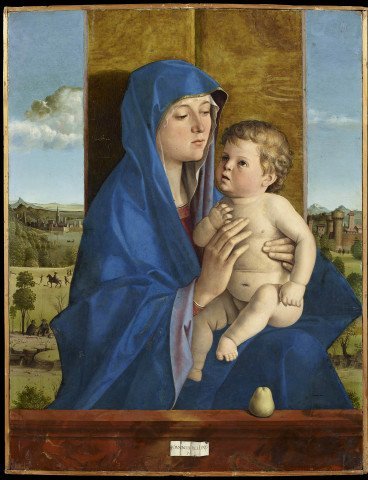Accademia Carrara in Bergamo quietly reopened: the victory of good taste
- Pisanello, Ritratto di Lionello d Este, 1441.
- Giovan Battista Moroni, Ritratto di Bernardo Spini, 1573.
- Giovan Battista Moroni, Ritratto di Pace Rivola Spini, 1573.
- Installation view, Accademia Carrara© AccademiaCarraraphotoSaraLuraschi.
- Giovanni Bellini, Madonna col Bambino, 1488.
- Installation view, Accademia Carrara© AccademiaCarraraphotoSaraLuraschi.
- Giovanni Bellini, Ritratto di Giovane, 1475-80.
- Installation view, Accademia Carrara© AccademiaCarraraphotoSaraLuraschi.
- Sandro Botticelli, Ritratto di Giuliano de Medici.
- Sandro Botticelli, Storie di Virginia Romana, 1423.
- Installation view, Accademia Carrara© AccademiaCarraraphotoSaraLuraschi.
- Installation view, Accademia Carrara© AccademiaCarraraphotoSaraLuraschi.
After seven years of restoration, the Accademia Carrara in Bergamo, one of the most important art galleries in Europe as well as a major tribute to Italian collecting, has quietly re opened a few weeks ago, even if the international art lovers who have flown into Italy from all over the world to attend the Venice Biennale and to visit the new Fondazione Prada didn’t seem to have paid too much attention to it.
Only 40 km away from Milan, this museum is a gem preserving about 1800 paintings, more than 3000 drawings, 130 sculptures and more than 1300 ancient books, not to mention bas-reliefs, precious objects and extensive graphic funds. And amongst the 600 artworks that will be permanently on show, you will come across masterpieces by Donatello, Pisanello, Antonio Vivarini, Andrea Mantegna, Carlo Crivelli, Giovanni Bellini, Sanddro Botticelli, Cima da Conegliano, Vittore Carpaccio, Raffaello, Evaristo Baschenis, Fra Galgario, Tiepolo, Pitocchetto, Canaletto, Piccio, Pellizza da Volpedo, besides the widest corpus of paintings in the world by Lorenzo Lotto and Giovan Battista Moroni.
The added value of the Accademia doesn’t only concern the important masterpieces by prestigious artists on show here, but actually the new exhibition criterion, that is a museographic approach thereby each room is a small show in itself, complete, well-structured and open to various readings according to a different range of audience.
An instance, amongst many, can be pinpointed in the room with the five works by Giovanni Bellini. If you turn your back to him, you will see, on the wall in the front, a work realized by Antonello da Messina with his son Jacobello. In between the two walls you will see running (ideally) the load-bearing axis of that Venetian paint which would have overshadowed Bergamo for centuries.
Beauty and art-historical events intertwine, with the same approach, in each of the 28 rooms, like in the one dedicated to Florence, where you can find a Botticelli, bought at a pawnbroker’s in Rome, in the 1800s; in the same room you can appreciate Pesellino, Benozzo Gozzoli, Benedetto da Maiano, a remarkable sequence worthy of a great Florentine museum such as the Uffizi.
You have a domestic feeling all around. Most of the pieces are small-scale artworks, conceived for private commissions. Collected (and then donated) by local aristocracy. This is why they are now displayed as they used to be in the houses of the most important collectors during the XIX century. They area precious paintings, to be look at closely, like the Durer’s, the Lorenzo Lotto’s, El Greco’s and the Fiamminghi’s.
Five centuries of great history flow by, bearing the fruits of an enlightened collecting, the result of 240 donations gatherd in over 200 years of history. The origin of the Accademia is owed to Giacomo Carrara (Bergamo 1714 – 1796) and to his sophisticated soul of a patron, collector and connoisseur of art and literature. The generosity of the Count of Carrara is not just limited to the donation of his artistic patrimony and the consequent constitution of an Art Accademy, but it goes even further to the erection of the neoclassic building which to this date hosts the museum. The heritage increased over the years thanks to the donations of Guglielmo Lochis, Giovanni Morelli (one of the most important Italian art historians of the XIX century) and, in 1998, of the scholar and dealer Federico Zeri.
There are many ways to approach such a complex and varied museum. You could proceed through it by lingering on those rooms, developed as cabinet de merveilles which have a strong emotional effect on the visitors. Else, you can read each room as the representation of art-historical issues. Furthermore, you can focus on the groups gathered according to common topics, like the still-life and the landscape. If you have little time, you can spotlight the masterpieces (at least 100 out of the 600 artworks on show).
However, the Accademia can also be visited following an opposite path, that is by pinpointing those antique artworks, yet so extraordinary modern, chosen and given by a smart collecting, during a period (the 1800s) whereby the collectors’ taste was more farsighted and wiser if compared to a history of art still young. The victory of the taste (of the market, too) over the dictatorship of theories. A lesson valid even nowadays for whoever is still struggling to understand that the market is one of the most powerful driving forces behind the evolution of art.
May 12, 2015












